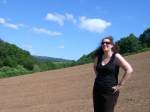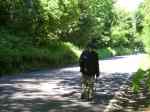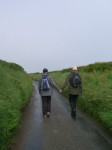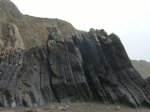I am walking with Roberta. Roberta is the editor of the collection Walking, Writing and Performance Autobiographical Texts by Deirdre Heddon, Carl Lavery and Phil Smith. In the introduction to this she admits that “I am not the most obvious person to guide you into a book about performance practices related to walking. Nobody would describe me as a walker by inclination, experience, or temperament.” This, she proposes, is because she is from the suburbs of Detroit, where of course everyone drives. (In fact, the link to Detroit is too neat, because the suburb of Detroit from which Roberta actually hails is in Windsor, Canada. Nevertheless, the atmosphere of the motor city travels.) Today, though, I am making Roberta walk. She warns me in advance that she may grumble, bitch, moan…
But the day is made for walking. The sky is a deep, uninterrupted blue that you could fall into. We walk up the driveway of her converted barn, “Detroit House”, onto a farm track. It smells of countryside already – cows, grass, milking sheds. Roberta says that since moving out here she has begun to learn things about the country, without even realising it; like when it’s Pheasant season, or why farms are stocking mixed breeds of cows. The track leads past North Ward Farm, down to the Tamar River. We pass directly under the impressive Calstock Viaduct, built in 1908. The edge of the river is a remarkable place to stand as on this side, we are in Devon, whilst on the other side, spitting distance really, is Cornwall (Calstock). A Cornish flag (black, white cross), marks the boundary change (and underneath it, a Pirate’s flag flaps). There’s a small pier here, for the ferry boat.
Having reached the river’s edge, we double back on ourselves, walking along a “path” that’s so overgrown with tall grasses it’s almost disappeared. The grasses are dried out, brittle. Yachts and rowing boats bob on the river. The current is strong, apparently, so swimming across to the other side is not recommended. Journeying this way, we pass in front of Roberta’s house, seeing it from another perspective. It really is an idyll. Above it, the outline of the lush, managed woods, within which nestles Cotehele Manor House.
Following the bend of the river, we come to a wooded lane, an almost luminous green corridor that offers temporary respite from the sun. Even in this short distance, our environment has changed repeatedly, from dirt track, to long grasses, to wood. Stepping out from the cover of the trees, the river view opens up again. This is as far as Roberta usually comes. We have walked her local walk and are now walking into the less familiar.
Passing behind a large house beside the river – Mary’s house – we arrive at a field that looks recently tilled. The uniformity of the brown is startling after the textures of deep greens. We need to cut across this field to reach a gate on the other side. The field is dry, dusty and very steep, but as we climb it, the view gets better. Roberta’s husband Paul has sketched a useful diagram of the route we’re meant to take (knowing that Roberta isn’t too familiar with the way). A gate is drawn at the edge of the field, and finding a gate, we immediately go through it. Before long, we are confronted with a veritable field of nettles. Very tall nettles. Almost as tall as Roberta, which is quite something. The nettles sting through our trousers and soon we have to walk with our arms above our heads. But as the nettles are so tall, I realise this will soon offer me (a fair bit shorter than Roberta) no protection. Common sense also tells us that, having climbed up the hill, it makes no sense to immediately descend the same hill. We decide we’ve probably taken a wrong turn and retrace our steps. The brambles scratch me and get tangled in Roberta’s curly hair.
Returning to the field we notice that there’s another gate nearby, this one clearly marked with a public footpath arrow. The path leads over a little bridge, and then onto another dirt track, beside which a huge field of maize is growing. It’s nearly noon, and the sun is high. The track is steep. This, on top of the steep hill just climbed, makes Roberta a little reticent (well, she had warned me). But we take our time, stop, rest, drink water, admire the spectacular view of the Tamar River below. (I learn that stopping in her tracks, and sitting wherever she happens to be, is Roberta’s own particular way of coping. She’s fine after a few moments of “time out” from walking.) The track is lined with bunches of tall stems of fox gloves. As it gets more dusty underfoot, we feel like we could be in a Western (as long as we don’t look at the lush land all around). Just after agreeing this, we spot a trailer that’s actually called, appropriately, “West”. And at the top of the hill, a working farm. We rest under the shade of a tree, like weary travellers, slugging greedily from the water bottle, drinking in the view below. Roberta, true to character and upbringing, admires the mix of the bucolic and the rusting farm debris. At the base of the tree, a snapped windscreen wiper lies abandoned.
The farm track leads us finally to the tarmac road. I’ve worried that the sun will reflect off it, making it feel even hotter, but in fact as soon as we step onto the road, there’s a cool, welcome breeze. It’s mostly flat or downhill too, which perks Roberta up. Sweet scented honeysuckles bloom in the wild hedges. This road leads us back to “Detroit House”, the end of our circular walk. As we arrive, a pair of buzzards circle in the field beside the barn, and a heron flies over. Roberta has travelled far from the suburbs of Detroit. Though she may not picture herself as much of a walker (can you ever take Detroit out of the girl?), she has in fact taken me on a magical walk, and we have mostly walked side by side, basking in the beauty of this landscape.

















